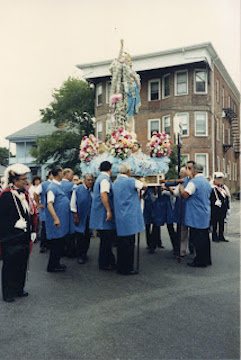Note: In 2013, I wrote about the Feast of Our Lady of Angels that occurs on Labor Day in my hometown. Nine years later it deserved to be updated.
Labor Day. Here in my village of Shelburne Falls, it’s a holiday weekend as summer fades and fall takes over. Earlier in my life, it meant the three-day Feast of Our Lady of Angels at the bottom of our street in my hometown of Fairhaven, Massachusetts.
First, a little history. At the start of the last century, the Portuguese migrated from the Azores and Madeira islands, an often treacherous trip by ship to the land of opportunity. Many found work in the textile mills or fishing industry in New Bedford. My grandparents on both sides of the family were among them.
Among the hopeful immigrants were four Azoreans who started the feast in North Fairhaven — across the harbor from New Bedford — to show their gratitude. They raised $800 to commission a sculptor back in the old country to carve a statue of Our Lady of Angels from wood. The 11-foot statue of Mary with cherubs at her feet arrived August 1930 and the first feast was held the next month. The statue is kept at St. Mary’s Church not far from the feast grounds.
The feast has Portuguese food, band music, games of chance, and auctions. (We kids hung near the auction, hoping someone would buy a large sweetbread and say “cut it up for the kids.”) We could hear the feast from our home, only three houses away, but we were at the feast grounds most of those days.
During the parade held Monday, men carry the statue from St. Mary’s Church up and down Main Street. The statue is adorned with wreaths of money given by the faithful as part of the promises they’ve made.
My father, Antone “Hawk” Medeiros, was one of the men who carried the statue for years — he is on the left, hoisting it onto his shoulder in the photo above — until he was 90. That was in 2013. He died two years later, around the time of the feast. We, of course, attended in honor of him. By the way, the tradition of carrying the statue continues with my brother, Tony Medeiros, who has done it for years.

As a child, I marched in the parade. I was dressed as Saint Teresa, a costume my mother made. She said I had the round face for it. That’s me in the photo above. Frankly, it’s the closest I will likely come to sainthood.
My sisters, Christine and Kij, went as angels when it was their turn. My brother fittingly was Saint Anthony.
When we were older, Christine and I sold soda, candy, and ice cream in one of the concession stands at the feast. We were stationed next to the women who were in charge of the malassadas — delicious deep-fried, yeasted dough that was rolled in sugar. People stand in long lines to buy them. Our father worked in the beer shack. Late at night, we sat on the beer cartons stacked against the wall rather than go home just yet.
The feast was such an important and enjoyable part of my early life, and I am glad to share it with you.
MORE: If you are interested in reading more of my writing, here’s the link to Amazon, where you will find my books: https://www.amazon.com/Joan-Livingston/e/B01E1HKIDG
By the way, I use my Portuguese heritage in several of my books, including my Isabel Long Mystery Series. Following the Lead, no. 6, will have a Nov. 3 release and is ready for pre-order. Thanks if you do. Here’s that link: https://mybook.to/followingthelead

